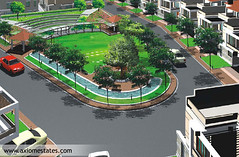Until recently, building automation, lighting controls, fire safety and other base building systems were designed and deployed to support a single building service and operated independently on proprietary network and cables. Green building’s emphasis on integrated design and whole-building performance has accelerated the convergence of these silos into a single platform, transforming a fragmented, vertical value chain into an integrated, horizontal value chain.
Simply put, the building management business is becoming flat and doing so fast. This convergence of information and communications technology and physical infrastructure in the built environment is providing building owners and occupants with actionable information about a building or space that allows them manage that building or space more effectively.
“Green development no longer simply represents an environmentally friendly label, but instead constitutes a new technology that has the capability to create larger profit margins for real estate,” concluded Richard Gollis of the Concord Group, a real estate advisory firm based in California, in “Urban Land,” a journal published by the Urban Land Institute.
| (Photo credit: nancyarora2020) |
Schneider Electric, the French distribution automation and energy management conglomerate, has invested more than $2 billion in strategic acquisitions – including Summit Energy Services, Telvent and Viridity Energy‘s EnergyCenter 2.0 product – that expand the capabilities of Schneider’s “StruxureWare Building Operation” platform, which it describes as “ an integration platform for intelligent monitoring, control, and management of energy, lighting, fire safety, security and HVAC.”
Meanwhile, a small number of well-positioned players in the property management industry have developed similar portfolio-management platforms by partnering with software and controls companies. At least one of these efforts is not only ready for prime time now but has apparently already been battle tested.
Jones Lang LaSalle (JLL), the global real-estate services and property management firm, engaged Pacific Controls, an emerging leader in the ICT-enabled automation and controls solutions providers for buildings and infrastructure based in New York City, to develop the IntelliCommand system.
The platform combines cloud-based, automation technology with flesh-and-blood engineers and facility management experts to operate building portfolios located worldwide at peak efficiency.
In November, JLL began using IntelliCommand for 24/7, real-time remote monitoring and control capabilities that ensure that all buildings systems operate at peak efficiency.
The near-term value proposition: lower energy costs.

IntelliCommand will reduce energy costs by an estimated 18% in the first two years of operations, according to JLL.
The long-term value proposition: fewer business disruptions, continuous commissioning, reduced operating risks and much, much more.
“With IntelliCommand, building equipment and operational issues are resolved before they become complaints, problems or failures,” said Chris Browne, International Director of Integrated Facilities Management at JLL.
But Browne believes the Big Prize for pursuing an integrated platform like IntelliCommand now is the ability to offer building owners and occupants new and compelling services and products made possible by the convergence of ICT and physical infrastructure in the built environment.
I agree.
By William Pentland
Taken from: http://www.forbes.com/sites/williampentland/2012/09/02/green-building-sparks-battle-for-the-built-environment/






No comments:
Post a Comment